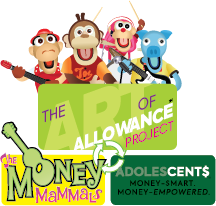
“Working to help parents raise money-smart kids.”
Hi!
Welcome to 3 (More) Ideas to Share and Save on a Money-Smart Monday.
I hope these thoughts inspire you to have more conversations with your children about money.
Before we jump in, I have a small favor to ask. If you’re enjoying this newsletter, then could you please share it with one friend who you think might benefit from the complimentary content I’m bringing to you each week?
— 1 —
The Age of Self-Sufficiency: My new short essay makes the case for why we need to start having money-smart conversations with our kids when they’re young. We’re living in a new age in which they will almost certainly be responsible for their own financial freedom.
Upcoming podcast guest Gene Natali, the CEO of Troutwood, told me that less than 1% of the next generation will have any kind of defined benefit program. I’ll share my conversation with Gene in a forthcoming newsletter.
Reminders of this trend seem to be all around me. Or maybe it’s just that my RAS (reticular activating system) has been triggered. During my morning reading session today, I encountered this description of the way the world used to be:
The system worked when large corporations survived a long time and were perceived to be longer lasting than nation-states.
Throughout the twentieth century […] expected duration [of large corporations] was more than sixty years. Longevity for large firms was greater; people stayed with large firms for their entire lives.
At the time of writing, firms stay in the top league by size (the so-called S&P 500) for only about between ten and fifteen years.
-Nassim Taleb, Skin in the Game
Our children will not be able to rely on big corporations to fund their retirements. And even if they work for these large companies, then it’s unlikely those firms will even be operating when their retirements roll around.
Okay, let’s move on to something a little lighter.
— 2 —
Printables for Kids: Many of our credit union partners and, by extension, their parent members found our monthly printables to be useful assets during the pandemic.
For a limited time, we’re keeping the demo version of our completely reimagined program, The Art of Allowance Project, open for you. If you’re a parent looking for ways to engage your children off-screen with fun, educational content, then you might benefit from our wonderful printables.
Do you have friends with kids who might like these money-smart activities too? Please let them know what we’re doing here. Also, I’d really appreciate it if you could ask them to sign up for this complimentary weekly newsletter to receive more information from me about how we can all do better raising money-smart children.
— 3 —
Incentives Matter: We incentivize our kids by “goosing the interest” we pay on the money in their Save jars, an idea I originally discovered in The First National Bank of Dad, a book by my podcast guest David Owen.
Today’s rates are too low to teach our children the value of long-term saving via traditional accounts. In fact, if our kids learn about inflation, then they might realize that money in these accounts is losing value. (Money in a savings account with a 0.1% interest rate is losing value in an economy with a 2.6% inflation rate as of March 2021.)
That’s why we offer our children a very generous 3% monthly (Yes, you read that right!) interest rate on their savings jars (which are now digital for the sake of convenience).
We also recommend to our credit union partners that they set up their Money Mammals accounts with a high rate of interest. Our terrific partner F&A Federal Credit Union does exactly that — 6.18% APY on the first $1,000 deposited! Now that’s an incentive that can make an impression on kids.
Of course, please consult with a financial or investment professional before engaging in any decisions that might affect your own financial well-being.
Until next week, enjoy the journey.
John, The Chief Mammal
Like what you just read? You can sign up for the newsletter here.

